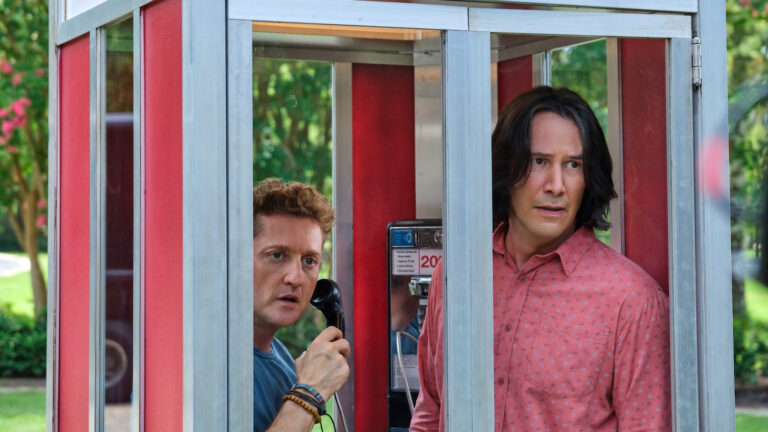Latest Article|September 3, 2020|Free
::Making Grown Men Cry Since 1992
6 min read
So you hate your job. You’re thinking of making a change. You’re dreaming, perhaps, of the glitz and glamor inherent in the film industry. Well, lucky for you, New Mexico is moving full steam ahead in its plan to lure Hollywood films to our fine state. 2007 saw the largest number of television series and feature films ever shot in New Mexico in a single year (more than 40 all totaled). So how do you break into the movie business out here in the dusty wilderness of New Mexico? Get Educated The vast majority of film work available to New Mexicans is “below-the-line” work. In the film industry, above-the-line jobs include creative talent such as writers, directors and producers. Below-the-line refers to a film’s technical crew, made up of construction workers, electricians, prop people, hair and makeup stylists, costume designers, production assistants, etc. These people generally earn less than above-the-line talent, but pay is quite high compared to other local wages. Most feature films coming to New Mexico employ between 25 and 200 locals and shoot an average of 30 days. To fill the wealth of below-the-line talent needed on any film shoot, Gov. Bill Richardson helped create the Film Technician’s Training Program in 2004. CNM in Albuquerque (www.cnm.edu/depts/at/programs/film), NMSU in Las Cruces (cmi.nmsu.edu), Eastern New Mexico University in Roswell (fine-arts.enmu.edu/art/programs/digital-cinema.shtml) and the Santa Fe Community College in Santa Fe (www.sfccnm.edu/sfcc/pages/2024.html) are the four schools designated to teach the FTTP. Classes range from simple production assistant workshops to production accountant training to multiyear cinematography curriculums.Classes at these school generally start in January. You can contact the individual schools for complete information on available courses. Look for the Union Label Once you’ve got your diploma, though, there’s no guarantee you’ll get a job. New Mexico is not a “right to work” state. It’s a closed shop state, meaning prospective employees must be members of an established trade union in order to get a job on a film set. On the downside, nonunion workers (even volunteers and interns) are generally SOL, while union workers are at the mercy of their representatives. (Members of the Writers Guild of America, for example, are entering the fourth month of their strike.) On the upside, producers who have signed on to collective bargaining agreements are obligated to meet contractual requirements such as minimum wages and benefits.So if you want to get a job on a film set, you’re probably going to have to join the union. The majority of New Mexico film technicians are members of the International Alliance of Theatrical Stage Employees, Moving Picture Technicians, Artists and Allied Crafts (IATSE) Local 480. (Transportation workers fall under New Mexico Teamsters Local 492, while camera operators belong to IATSE Local 600.) The union keeps a tight roster and any prospective members must complete a multistep application process. Previous membership in a craft union, an industry-recognized diploma or personal references from Local 480 members are just a few of the basic requirements. There’s a one-time $600 initiation fee plus membership dues both local and international are required for life , even if you withdraw or are expelled. It’s a major decision, and one that shouldn’t be undertaken unless you’re quite serious about working long-term in the film biz. To contact the union, go to www.iatselocal480.com. There are a few entry-level positions that are not union-based, such as accounting clerks, production secretaries, animal wranglers and caterers. The most common entry level position in film, though, is the production assistant (essentially a glorified gopher). As with most jobs in film, however, you can’t get a job without experience and you can’t get experience without a job. Your best bet is simply to haunt the “For Locals” bulletin boards at the New Mexico Film Office website (www.nmfilm.com/locals) and the “Burquewood” listings in the back of the Alibi . Whenever crew calls go up asking for a position you’re interested in, call or e-mail your résumé to the listed line producer or unit production manager (the people most often in charge of hiring below-the-line positions). In addition, people with prior P.A. experience and those who have completed a training course in P.A. work can have their names listed on the New Mexico Film Office’s Production Assistant list. (E-mail film@nmfilm.com for a P.A. list form.) Extra, Extra But what if you want to be in front of the camera? Principal actors are above-the-line talent and are members of the Screen Actors Guild. Extras (aka background talent) are neither and may represent your best chance of getting onto a film set. Check in regularly on the “Casting Calls” section of the NMFO’s For Locals bulletin board (www.nmfilm.com/locals) and the “Burquewood” listings in the back of the Alibi , and you’ll see what productions are looking for (this week it may be “Asians age 15-25,” next week it might be “biker types.”) Not all local productions post casting calls on the website, however, and hooking up with an extras casting director may be helpful if you want regular employment. New Mexico Casting Database (nmcastingdatabase.com), Anastarzi Casting (www.anastarzi.com), Elizabeth Gabel (egabel@msn.com) and Film Savage (www.filmsavage.com) are just a few places prospective extras might go in search of work.Bear in mind that background talent is often isolated from the primary crew and the chances of “getting discovered” as an extra are slim. Hours are long, work is tedious. Like all film crew positions, jobs come and go with the productions, rarely lasting more than a month at a stretch. Still, it’s better than sitting in your living room, watching AMC and wishing you were involved somehow in the glamorous life of Hollywood.



